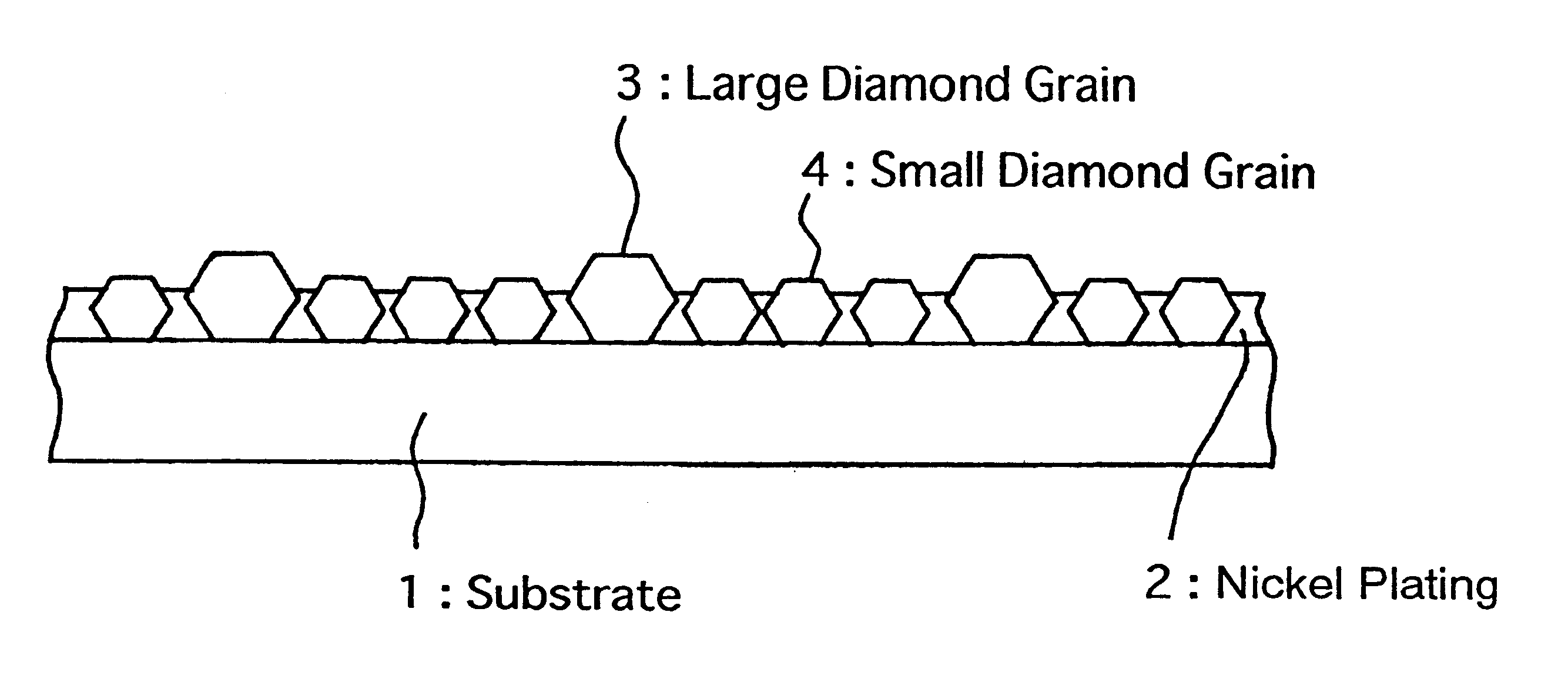Dressing tool for the surface of an abrasive cloth and its production process
- Summary
- Abstract
- Description
- Claims
- Application Information
AI Technical Summary
Benefits of technology
Problems solved by technology
Method used
Image
Examples
first embodiment
In a first embodiment of the present invention, as shown in FIG. 1, diamond grains of two or more groups classified in terms of an average particle diameter are fixed in mixture, and the upper end of small diamond grains 4 are also projected over nickel plating 2.
Desirably, in the mixture of the diamond grains, the number of large diamond grains 3 is equal to or less than the small diamond grains 4. Preferably, the number of the small grains is 2 to 20, or further 5 to 15, relative to the number "1 " of the large grains. Preferably, the large diamond grains 3 have diameters of 100 to 300 .mu.m, and small diamond grains 4 have 60 to 80% of the diameter of the large diamond grains 3.
Preferable thickness of the nickel plating 2 is 50 to 70% of the diameter of the large diamond grains 3.
FIG. 2 shows a plating apparatus for use in preparing a dressing tool of the present invention for dressing the surface of an abrasive cloth.
The large and small diamond grains premixed in the predetermin...
examples
The present invention will be explained more in detail by the following examples in reference to the accompanying drawings.
FIG. 1 shows an exemplary dressing tool of the present invention. In this dressing tool, a disk substrate made of nickel alloy having a thickness of 2 mm and an outer diameter of 100 mm was provided with diamond grains having an average grain size of 180 .mu.m and another group of diamond grains having an average grain size of 130 .mu.m mixed in a ratio of 1:10. This mixing ratio was determined by filling a vessel having a unit volume with each group of diamond grains and estimated by the volume ratio of the resultant volumes. As a result, actual mixing ratio of diamond grains should be higher than the above mixing ratio. Then, the thickness of nickel plating was 110 .mu.m.
FIG. 2 shows a plating apparatus for use in preparing the exemplary dressing tool of the present invention. In a plating solution diamond grains having an average grain size of 180 .mu.m and a...
second embodiment
Now, a second embodiment of the present invention will be explained below in reference to the accompanying drawings.
FIG. 9 shows a second embodiment of a dressing tool of the present invention. This dressing tool essentially has a mixture of fixed diamond grains 3' having a predetermined average diameter with other fixed particles 6, smaller than the diamond grains, the upper end of which is projected over nickel plating 2.
Materials of the other particles include ZrO.sub.2, Al.sub.2 O.sub.3, Si.sub.3 N.sub.4, cubic boron nitride or ceramics, and hard plastics such as polyacetals (Delrin of DuPont), PET, polyester (Teflon) and polyurethane.
The production process of the second embodiment of the dressing tool of the present invention has the same steps of the first embodiment disclosed above. Namely, it includes steps of mixing the particles at the predetermined ratio, developing first thin plating, removing the floated particles and building up second plating to form an ultimate nicke...
PUM
| Property | Measurement | Unit |
|---|---|---|
| Linear density | aaaaa | aaaaa |
| Thickness | aaaaa | aaaaa |
| Diameter | aaaaa | aaaaa |
Abstract
Description
Claims
Application Information
 Login to View More
Login to View More - R&D
- Intellectual Property
- Life Sciences
- Materials
- Tech Scout
- Unparalleled Data Quality
- Higher Quality Content
- 60% Fewer Hallucinations
Browse by: Latest US Patents, China's latest patents, Technical Efficacy Thesaurus, Application Domain, Technology Topic, Popular Technical Reports.
© 2025 PatSnap. All rights reserved.Legal|Privacy policy|Modern Slavery Act Transparency Statement|Sitemap|About US| Contact US: help@patsnap.com



